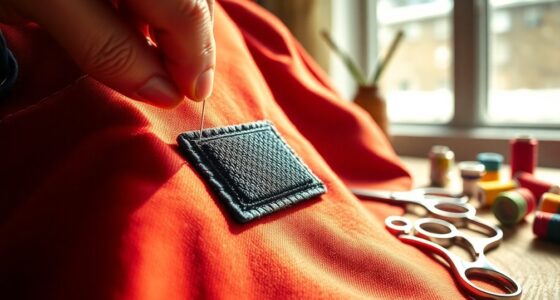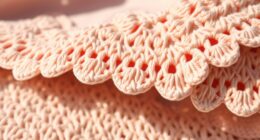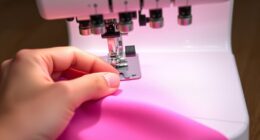To align fabric patterns at seams, start by carefully examining the pattern repeat and positioning your pieces before cutting. Use plenty of pins or clips to secure edges, matching motifs precisely along seam lines. Sew slowly, checking frequently and making small adjustments as you go. Press seams open or to one side to maintain alignment and reduce bulk. With patience and attention to detail, you’ll achieve seamless pattern flow—continue to discover expert tips to perfect this craft.
Key Takeaways
- Carefully examine the fabric’s pattern repeat and plan piece placement before cutting to ensure alignment at seams.
- Use pins, clips, or tailor’s chalk marks to secure and identify pattern match points during sewing.
- Sew slowly, frequently checking pattern alignment, and make small adjustments as needed for precision.
- Trim seam allowances and notch curves to create smooth, flat seams that support pattern flow.
- Press seams carefully in the desired direction to maintain pattern continuity and achieve a polished finish.

Pattern matching is a powerful technique used in programming and data analysis to identify specific sequences or structures within larger datasets. When it comes to sewing, especially with matching fabric, this concept becomes essential for achieving professional-looking garments. Properly aligning fabric patterns at seams enhances the overall aesthetic and demonstrates your attention to detail. Understanding the importance of matching fabric, along with mastering specific sewing techniques, allows you to create seamless, visually appealing finished pieces.
To start, you need to carefully select your fabric and consider the pattern’s repeat size. Matching fabric patterns isn’t just about lining up lines or motifs; it’s about ensuring the design flows smoothly across seams. Once you’ve cut your fabric pieces, lay them flat and examine the pattern repeat. You want to position your pattern pieces so that the design lines up exactly where the seams will join. This might mean adjusting the placement of pattern pieces on the fabric before cutting. It’s a step that requires patience but greatly improves the final look of your garment.
When sewing, the key sewing techniques involve careful pinning and precise stitching. Use plenty of pins along the edges where the fabric pieces meet, aligning the pattern motifs as you pin. This helps keep everything in place and prevents shifting during sewing. Some sewists prefer to use clips or tailor’s chalk to mark the pattern match points, making it easier to keep everything aligned. As you sew, sew slowly and steadily, frequently checking that the pattern remains aligned. Small adjustments during sewing can prevent misalignment, which becomes glaringly obvious once the garment is finished.
Another useful technique involves trimming and notching seam allowances. By trimming seam allowances to reduce bulk and notching curves, you can achieve smoother, flatter seams that help your patterns align more precisely. Pressing seams open or to one side with an iron also plays an important role. Proper pressing ensures the fabric stays in the correct position, which is essential when matching intricate patterns. For large or complex designs, consider basting the fabric pieces together first with long, loose stitches. Basting allows you to check the pattern match before final sewing, giving you a chance to make adjustments if needed. Additionally, understanding how seam allowances impact pattern alignment can further refine your finished look.
Ultimately, matching fabric patterns at seams demands patience and attention to detail, but the results speak for themselves. Applying these sewing techniques, coupled with a keen eye for pattern placement, transforms your project from ordinary to polished. With practice, you’ll develop an intuitive sense of how to manipulate fabric to align patterns seamlessly, elevating your craftsmanship and making every project look professionally finished.
Frequently Asked Questions
How Do I Choose the Best Fabric Pattern for Matching?
To select the best fabric pattern for matching, look for designs with clear fabric symmetry and consistent pattern orientation. Patterns with symmetrical repeats, like plaids or stripes, make matching easier and more seamless. Avoid irregular or asymmetrical prints that can be difficult to align. Check how the pattern repeats and ensure the orientation stays consistent across fabric pieces. This helps your seam lines look professional and polished.
What Tools Are Essential for Precise Pattern Matching?
Ever wonder what tools make fabric alignment and seam matching easier? You’ll need a clear measuring tape or ruler to guarantee accurate seam placement and pattern alignment. Fabric weights or clips hold the fabric steady, preventing shifting during sewing. A seam ripper helps correct any mistakes, while marking tools like chalk or fabric pens guide your pattern matching. These tools ensure precise seam matching and flawless pattern alignment every time.
How Do I Handle Pattern Matching on Curved Seams?
To handle pattern matching on curved seams, start by carefully marking your pattern pieces and pinning them in place. Use curved seam adjustments to make certain the pattern aligns smoothly along the curve. Take your time, matching complex patterns precisely, and sew slowly to maintain accuracy. You might also use clips or curved pins to hold everything steady. This approach ensures your fabric patterns match seamlessly, even on intricate curved seams.
Can Pattern Matching Be Done on Stretchy or Knit Fabrics?
A stitch in time saves nine, especially with stretchy or knit fabrics. You can do pattern matching on these materials, but you need to be extra careful with the fabric grain and pattern symmetry. Stretchy fabrics tend to shift, so pin carefully and use a stretch stitch or zigzag to maintain alignment. Always test on scraps first to guarantee your pattern stays true, even when the fabric stretches.
How Do I Correct Mismatched Patterns After Sewing?
If you notice mismatched patterns after sewing, carefully unpick the seam within the seam allowances, then realign the fabric so the pattern matches at the seam and fabric grain. Pin everything securely before resewing, ensuring the pattern lines up correctly. Take your time to adjust the fabric along the seam allowances, and double-check pattern alignment before sewing again. This approach helps you correct mismatched patterns effectively.
Conclusion
Now that you know the secrets to perfect pattern matching at seams, imagine the stunning garments you’ll create. But remember, even the tiniest misalignment can make or break the look. Will your next project turn out flawless, or will a hidden mismatch reveal itself? The choice is yours—embrace these techniques, stay attentive, and push your skills further. The perfect finish is within your grasp. Are you ready to see what you can truly achieve?








